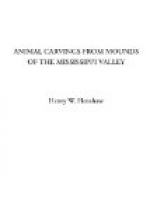As a theory to account for the number and character of these animal carvings the totemic theory is perhaps as tenable as any. The origin and significance of the carvings may, however, involve many different and distinct ideas. It is certain that it is a common practice of Indians to endeavor to perpetuate the image of any strange bird or beast, especially when seen away from home, and in order that it may be shown to his friends. As what are deemed the marvellous features of the animal are almost always greatly exaggerated, it is in this way that many of the astonishing productions noticeable in savage art have originated. Among the Esquimaux this habit is very prominent, and many individuals can show etchings or carvings of birds and animals exhibiting the most extraordinary characters, which they stoutly aver and doubtless have come to believe they have actually seen.
ANIMAL MOUNDS.
As having, for the purposes of the present paper, a close connection with the animal carvings, another class of remains left by the Mound-Builders—the animal mounds—may next engage attention. As in the case of the carvings, the resemblance of particular mounds to the animals whose names they bear is a matter of considerable interest on account of the theories to which they have given rise.
The conclusion reached with respect to the carvings that it is safe to rely upon their identification only in the case of animals possessed of striking and unique characters or presenting unusual forms and proportions, applies with far greater force to the animal mounds. Perhaps in none of the latter can specific resemblances be found sufficient for their precise determination. So general are the resemblances of one class that it has been an open question among archaeologists whether they were intended to represent the bodies and arms of men, or the bodies and wings of birds. Other forms are sufficiently defined to admit of the statement that they are doubtless intended for animals, but without enabling so much as a reasonable guess to be made as to the kind. Of others again it can be asserted that whatever significance they may have had to the race that built them, to the uninstructed eyes of modern investigators they are meaningless and are as likely to have been intended for inanimate as animate objects.
There are many examples among the animal shapes that possess peculiarities affording no hint of animals living or extinct, but which are strongly suggestive of the play of mythologic fancy or of conventional methods of representing totemic ideas. As in the case of the animal carvings, the latter suggestion is perhaps the one that best corresponds with their general character.
THE “ELEPHANT” MOUND.
By far the most important of the animal mounds, from the nature of the deductions it has given rise to, is the so-called “Elephant Mound,” of Wisconsin.




